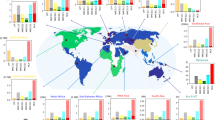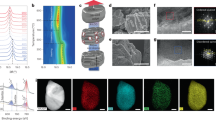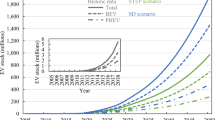Abstract
Achieving electric mobility targets is crucial for global decarbonization goals and the transition to electric vehicles depends on the availability of lithium-ion batteries, the preferred traction battery for electric vehicles. Demand and supply models for lithium, a critical energy material in batteries, largely ignore time, geography and mining dynamics when evaluating mineral sufficiency. We developed a resource dispatch model with data at the mineral deposit level and found that, if trends towards larger battery packs in electric vehicles continue, >85 new deposit openings may be needed by 2050. Moderating battery size and achieving robust battery recycling at global scales can substantially decrease new lithium deposit openings, with the very best case leading to just 15 openings by 2050. Ambitious recycling and recovery targets for lithium require global policy intervention, but will reduce supply concentration and the creation of new frontline communities by reducing mine openings.
This is a preview of subscription content, access via your institution
Access options
Access Nature and 54 other Nature Portfolio journals
Get Nature+, our best-value online-access subscription
$32.99 / 30 days
cancel any time
Subscribe to this journal
Receive 12 digital issues and online access to articles
$119.00 per year
only $9.92 per issue
Buy this article
- Purchase on SpringerLink
- Instant access to full article PDF
Prices may be subject to local taxes which are calculated during checkout





Similar content being viewed by others
Data availability
Data used in the present study were extracted from the following sources: ICCT Roadmap v.2.2 for on-road vehicle sales forecast, Benchmark Mineral Intelligence for battery chemistry forecast and battery requirements for stationary power storage, EV Volumes for battery capacity estimates for cars, multiple model catalogues for truck, buses and 2–3 wheelers (documented in Supplementary Data 1). Lithium intensity was obtained as default results from BatPaC 5.1 and SolidPac. All lithium deposit characteristics were obtained from public company reports, documented in Supplementary Data 2. Corporate tax and royalty rates were obtained from current legislation for each country, documented in Supplementary Data 3. All data required to reproduce the model results are available via Zenodo at https://doi.org/10.5281/zenodo.14532951 (ref. 69). Source data are provided with this paper.
Code availability
All codes required to reproduce model results are available in the Supplementary Information and via Zenodo at https://doi.org/10.5281/zenodo.14532951 (ref. 69).
References
Alšauskas, O. et al. Global EV Outlook 2024. Moving towards increased affordability. Electric Vehicles Initiative https://www.iea.org/reports/global-ev-outlook-2024 (2024).
Owen, J. R. et al. Energy transition minerals and their intersection with land-connected peoples. Nat. Sustain. 6, 203–211 (2023).
Bhuwalka, K., Kirchain, R. E., Olivetti, E. A. & Roth, R. Quantifying the drivers of long-term prices in materials supply chains. J. Ind. Ecol. 27, 141–154 (2023).
Aguilar Lopez, F., Billy, R. G. & Müller, D. B. Evaluating strategies for managing resource use in lithium-ion batteries for electric vehicles using the global MATILDA model. Resour. Conserv. Recycl. 193, 106951 (2023).
Dunn, J., Slattery, M., Kendall, A., Ambrose, H. & Shen, S. Circularity of lithium-ion battery materials in electric vehicles. Environ. Sci. Technol. 55, 5189–5198 (2021).
Olivetti, E. A., Ceder, G., Gaustad, G. G. & Fu, X. Lithium-ion battery supply chain considerations: analysis of potential bottlenecks in critical metals. Joule https://doi.org/10.1016/j.joule.2017.08.019 (2017).
Watari, T., Nansai, K. & Nakajima, K. Review of critical metal dynamics to 2050 for 48 elements. Resour. Conserv. Recycl. 155, 104669 (2020).
Ambrose, H. & Kendall, A. Understanding the future of lithium: part 1, resource model. J. Ind. Ecol. https://doi.org/10.1111/jiec.12949 (2020).
Egbue, O., Long, S. & Dae Kim, S. Resource availability and implications for the development of plug‐in electric vehicles. Sustainability 14, 1665 (2022).
Zhang, C., Zhao, X., Sacchi, R. & You, F. Trade-off between critical metal requirement and transportation decarbonization in automotive electrification. Nat. Commun. 14, 1616 (2023).
Department of Energy. Notice of final determination on 2023 DOE critical materials list. Federal Register 88, 51792–51798 (2023).
Zhao, Y. et al. Recycling of sodium-ion batteries. Nat. Rev. Mater. 8, 623–634 (2023).
Abraham, K. M. How comparable are sodium-ion batteries to lithium-ion counterparts? ACS Energy Lett. 5, 3544–3547 (2020).
US Geological Survey. Lithium—Mineral Commodity Summaries (USGS, 2024); https://pubs.usgs.gov/periodicals/mcs2024/mcs2024-lithium.pdf
Critical Minerals Market Review 2023 (IEA, 2023).
Watari, T., Nansai, K. & Nakajima, K. Major metals demand, supply, and environmental impacts to 2100: a critical review. Resour. Conserv. Recycl. 164, 105107 (2021).
Vikström, H., Davidsson, S. & Höök, M. Lithium availability and future production outlooks. Appl. Energy 110, 252–266 (2013).
Calvo, G., Valero, A. & Valero, A. Assessing maximum production peak and resource availability of non-fuel mineral resources: analyzing the influence of extractable global resources. Resour. Conserv. Recycl. 125, 208–217 (2017).
Greim, P., Solomon, A. A. & Breyer, C. Assessment of lithium criticality in the global energy transition and addressing policy gaps in transportation. Nat. Commun. 11, 4570 (2020).
Northey, S., Mohr, S., Mudd, G. M., Weng, Z. & Giurco, D. Modelling future copper ore grade decline based on a detailed assessment of copper resources and mining. Resour. Conserv. Recycl. 83, 190–201 (2014).
Ali, S. H. et al. Mineral supply for sustainable development requires resource governance. Nature 543, 367–372 (2017).
Tokimatsu, K. et al. Long-term demand and supply of non-ferrous mineral resources by a mineral balance model. Miner. Econ. 30, 193–206 (2017).
Han, S., Zhenghao, M., Meilin, L., Xiaohui, Y. & Xiaoxue, W. Global supply sustainability assessment of critical metals for clean energy technology. Resour. Policy 85, 103994 (2023).
Woodley, L. et al. Climate impacts of critical mineral supply chain bottlenecks for electric vehicle deployment. Nat. Commun. 15, 1–13 (2024).
Kumar, P., Singh, R. K., Paul, J. & Sinha, O. Analyzing challenges for sustainable supply chain of electric vehicle batteries using a hybrid approach of Delphi and Best-Worst Method. Resour. Conserv. Recycl. 175, 105879 (2021).
Jones, E. C. Lithium supply chain optimization: a global analysis of critical minerals for batteries. Energies 17, 2685 (2024).
Net Zero Roadmap: A Global Pathway to Keep the 1.5 °C Goal in Reach (International Energy Agency, 2023); www.iea.org/reports/net-zero-roadmap-a-global-pathway-to-keep-the-15-0c-goal-in-reach
Sen, A. & Miller, J. Vision 2050: Update on the Global Zero-Emission Vehicle Transition in 2023 (International Council on Clean Transportation, 2023); https://theicct.org/publication/vision-2050-global-zev-update-sept23
Benson, T. R., Coble, M. A. & Dilles, J. H. Hydrothermal enrichment of lithium in intracaldera illite-bearing claystones. Sci. Adv. 9, eadh8183 (2023).
Gardiner, N. J., Jowitt, S. M. & Sykes, J. P. Lithium: critical, or not so critical? Geoenergy 2, 0–5 (2024).
Ease of doing business scores. World Bank Group https://archive.doingbusiness.org/en/data/doing-business-score (2020).
Zhao, H., Wang, Y. & Cheng, H. Recent advances in lithium extraction from lithium-bearing clay minerals. Hydrometallurgy 217, 106025 (2023).
Zhou, W., Cleaver, C. J., Dunant, C. F., Allwood, J. M. & Lin, J. Cost, range anxiety and future electricity supply: a review of how today’s technology trends may influence the future uptake of BEVs. Renew. Sustain. Energy Rev. 173, 113074 (2023).
Shaffer, B., Auffhammer, M. & Samaras, C. Make electric vehicles lighter to maximize climate and safety benefits. Nature 598, 254–256 (2021).
Creutzig, F. et al. Demand-side strategies key for mitigating material impacts of energy transitions. Nat. Clim. Chang. 14, 561–572 (2024).
Melin, H. E. et al. Global implications of the EU battery regulation. Science 373, 384–387 (2021).
Baum, Z. J., Bird, R. E., Yu, X. & Ma, J. Lithium-ion battery recycling—overview of techniques and trends. ACS Energy Lett. 7, 712–719 (2022).
Kamran, M., Raugei, M. & Hutchinson, A. A dynamic material flow analysis of lithium-ion battery metals for electric vehicles and grid storage in the UK: assessing the impact of shared mobility and end-of-life strategies. Resour. Conserv. Recycl. 167, 105412 (2021).
Calderon, J. L., Smith, N. M., Bazilian, M. D. & Holley, E. Critical mineral demand estimates for low-carbon technologies: what do they tell us and how can they evolve? Renew. Sustain. Energy Rev. 189, 113938 (2024).
Roadmap v2.2 Documentation. ICCT https://theicct.github.io/roadmap-doc/versions/v2.2 (2022).
Aguilar Lopez, F., Billy, R. G. & Müller, D. B. A product–component framework for modeling stock dynamics and its application for electric vehicles and lithium-ion batteries. J. Ind. Ecol. 26, 1605–1615 (2022).
Greene, D. L. & Leard, B. Trends in scrappage and survival of U.S. light-duty vehicles. Transp. Res. Part A Policy Pract. 180, 103982 (2024).
Battery installation tracker and xEV Share tracker by country. EV Volumes https://ev-volumes.com/product/ev-volumes/ (2022).
Parés Olguín, F., Iskakov, G. & Kendall, A. US-Mexico second-hand electric vehicle trade: battery circularity and end-of-life policy implications. Transp. Res. Part D Transp. Environ. 125, 103934 (2023).
New but used: the electric vehicle transition and the global second-hand car trade. OECD https://doi.org/10.1787/28ee4515-en (2023).
Lithium ion Batteries. Benchmark Mineral Intelligence www.benchmarkminerals.com/lithium-ion-batteries (2023).
Yearly electricity data. EMBER https://ember-energy.org/data/yearly-electricity-data (2023).
Kubal, J. J. et al. Battery Performance and Cost (BatPaC) Model Software, version 5.1. (Argonne National Laboratory, 2023).
Yu, L., Bai, Y., Polzin, B. & Belharouak, I. Unlocking the value of recycling scrap from Li-ion battery manufacturing: challenges and outlook. J. Power Sources 593, 233955 (2024).
European Parliament. Regulation (EU) 2023/1542 of the European Parliament and of the Council of 12 July 2023 concerning batteries and waste batteries, amending Directive 2008/98/EC and Regulation (EU) 2019/1020 and repealing Directive 2006/66/EC, 1–117 (2023).
Recycling of Traction Battery Used in Electric Vehicle—Recycling—Part 2: Materials Recycling Requirements (Standardization Administration of the People’s Republic of China, 2020); www.codeofchina.com/standard/GBT33598.2-2020.html
Jaskula, B. 2018 Minerals Yearbook Lithium (USGS, 2018); https://pubs.usgs.gov/myb/vol1/2018/myb1-2018-lithium.pdf
Miatto, A., Wolfram, P., Reck, B. K. & Graedel, T. E. Uncertain future of American lithium: a perspective until 2050. Environ. Sci. Technol. 55, 16184–16194 (2021).
Hocking, M., Kan, J., Terry, C. & Begleiter, D. Industry Lithium 101 ‘Welcome to the Lithium-Ion Age Global’ (Deutsche Bank Markets Research, 2016).
Mineral Commodity Summaries 2023: Appendix C Reserve and Resources (USGS, 2023).
Castillo, E. & Eggert, R. Reconciling diverging views on mineral depletion: a modified cumulative availability curve applied to copper resources. Resour. Conserv. Recycl. 161, 104896 (2020).
Bird, D. Lithium—Deficits Still on the Horizon But the Pace of New Supply Is Picking Up. Lithium Commodity Market Report (RFC Ambrian, 2023).
Andrade, L. B. et al. From exploration to production: understanding the development dynamics of lithium mining projects. Resour. Policy 99, 105423 (2024).
Nicolaci, H. et al. Direct lithium extraction: a potential game changing technology. Goldman Sachs https://www.goldmansachs.com/pdfs/insights/pages/gs-research/direct-lithium-extraction/report.pdf (2023).
Haddad, A. Z. et al. How to make lithium extraction cleaner, faster and cheaper—in six steps. Nature 616, 245–248 (2023).
Atkinson, B. The Lithium Price Reversion Risk. A Look at Long Term Lithium Supply, Demand, and Incentive Prices (Optar Capital, 2023); www.optarcapital.com/wp-content/uploads/2023/07/2023-07-Lithium-Price-Reversion-Risk-0.pdf
Lazenby, H. Lithium price surge unlikely to return: Fitch. The Northern Miner (28 June 2024).
Wang, C. N., Bayer, J., Dang, T. T. & Hsu, H. P. Evaluation of world lithium mining projects using hybrid MCDM model. Miner. Eng. 189, 107905 (2022).
Sun, X. et al. Reducing supply risk of critical materials for clean energy via foreign direct investment. Nat. Sustain. 7, 672–681 (2024).
Yaksic, A. & Tilton, J. E. Using the cumulative availability curve to assess the threat of mineral depletion: the case of lithium. Resour. Policy 34, 185–194 (2009).
Fleming, M., Kannan, S. G. & Eggert, R. Long-run availability of mineral resources: the dynamic case of lithium. Resour. Policy 97, 105226 (2024).
Ovalle, A. Analysis of the discount rate for mining projects. In MassMin 2020: Proc. of the Eighth International Conference & Exhibition on Mass Mining (eds Castro, R. et al.) 1048–1064 (University of Chile, 2020).
Gosson, G. & Wood, G. Factors to consider when determining appropriate discount rate for project NPV. CIM https://mrmr.cim.org/en/library/magazine-articles/factors-to-consider-when-determining-appropriate-discount-rate-for-project-npv (2013).
Busch, P. pmbusch/lithium-supply: final submission. Zenodo https://doi.org/10.5281/zenodo.14532951 (2025).
Acknowledgements
This work was funded by grants from the Heising-Simons Foundation (grant no. 2023-4360 to A.K.) and ClimateWorks Foundation (grant no. G-2308-802319017 to A.K.). We would like to acknowledge A. DePew’s assistance in collecting data on battery size for buses, trucks and 2–3 wheelers. We also thank A. Perez for his helpful advice about optimization, R. Hwang for his insightful feedback on scenarios and interpretation and the ICCT for sharing detailed information on their Roadmap.
Author information
Authors and Affiliations
Contributions
A.K. and P.B. designed the research, conceptualization and methodology. P.B., Y.C. and P.O. collected the data. P.B. and A.K. performed the research, analysed the data and created the figures. P.B. and A.K. wrote the paper. All the authors reviewed and approved the final version of the paper.
Corresponding author
Ethics declarations
Competing interests
The authors declare no competing interests.
Peer review
Peer review information
Nature Sustainability thanks Karan Bhuwalka, Romain Billy and I. Daniel Posen for their contribution to the peer review of this work.
Additional information
Publisher’s note Springer Nature remains neutral with regard to jurisdictional claims in published maps and institutional affiliations.
Supplementary information
Supplementary Information
Supplementary Figs. 1–19 and Tables 1–6.
Supplementary Data
Supplementary Data 1: List of manufacturers for battery capacity for full BEV: 2 wheelers, 3 wheelers, bus and trucks. Supplementary Data 2: Lithium deposit database. Supplementary Data 3: Royalty rate, royalty base and corporate tax rate by country.
Source data
Source Data Figs. 1–5
Source Data Fig. 1: Results to re-create figure (see sheet ‘Fig1a’ and ‘Fig1b’). Source Data Fig. 2: Results to re-create figure (see sheet ‘Fig2a’, ‘Fig2b’ and ‘Fig2c’). Source Data Fig. 3: Results to re-create figure (see sheet ‘Fig3’). Source Data Fig. 4: Results to re-create figure (see sheet ‘Fig4’). Source Data Fig. 5: Results to re-create figure (see sheet ‘Fig5a’ and ‘Fig5b’).
Rights and permissions
Springer Nature or its licensor (e.g. a society or other partner) holds exclusive rights to this article under a publishing agreement with the author(s) or other rightsholder(s); author self-archiving of the accepted manuscript version of this article is solely governed by the terms of such publishing agreement and applicable law.
About this article
Cite this article
Busch, P., Chen, Y., Ogbonna, P. et al. Effects of demand and recycling on the when and where of lithium extraction. Nat Sustain 8, 773–783 (2025). https://doi.org/10.1038/s41893-025-01561-5
Received:
Accepted:
Published:
Issue date:
DOI: https://doi.org/10.1038/s41893-025-01561-5



